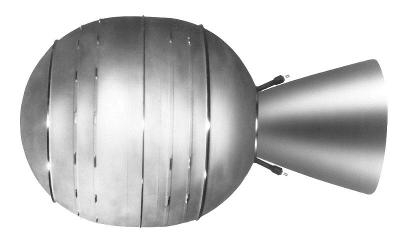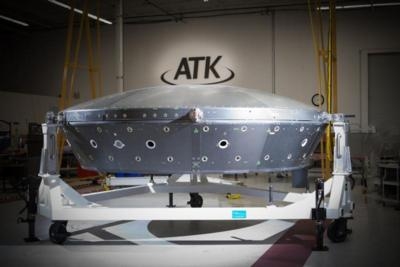Fri, Jul 04, 2014
STAR 48 Rocket Motor Carried LDSD Vehicle To Altitude Of Over 180,000 Feet
ATK supported NASA Saturday as it moved one step closer to landing advanced payloads on Mars following the successful test of a next generation braking system. ATK provided both the rocket motor and test vehicle backbone for the test of NASA's experimental Low-Density Supersonic Decelerator (LDSD). During the June 28 test at the Pacific Missile Range Facility at Barking Sands, Kauai, Hawaii, a balloon carried the test vehicle from the Navy test range to an altitude of about 120,000 feet. At 1105 local time, the LDSD test vehicle dropped away from the balloon and the ATK STAR 48B motor ignited to accelerate the vehicle to more than Mach 3.8 and an altitude of over 180,000 feet.

The flight test simulated the low pressure and punishing speeds experienced by payloads dropped into the Mars atmosphere. ATK's STAR 48B rocket motor provided the axial propulsion for the test, while the ATK-manufactured Core Structure Assembly (CSA) served as the platform for two breakthrough technologies from NASA's Jet Propulsion Laboratory (JPL): an inflatable Kevlar tube around the vehicle, called the Supersonic Inflatable Aerodynamic Decelerator, and a mammoth parachute called the Supersonic Disk Sail Parachute. These new drag devices will pave the way for delivery of increasingly larger payloads to the surface of Mars.
"ATK has long supported JPL and its missions to Mars," said Cary Ralston, vice president and general manager of ATK's Missile Products division. "ATK was an integral part of the team for Mars Pathfinder and Mars Exploration Rover, providing propulsion for the Delta II launch vehicle, and retro rockets and gas generators for the entry, descent and landing system used to safely deliver the rovers to the surface of Mars."

The STAR 48B propulsion system was produced at the ATK facility in Elkton, Maryland. The CSA for the LDSD test vehicle was developed and built at ATK's Space Components facility in San Diego, California. The CSA incorporates new design features required to handle the massive loads associated with deployment of the drag devices. Among other applications, this new drag technology will enable delivery of the supplies and materials needed for long-duration missions to the red planet.
While the LDSD team expects to learn a great deal from this test, NASA has two more saucer-shaped test vehicles forthcoming, with plans to test them in the summer of 2015.
(Images provided by ATK)
More News
A Puff Of Smoke Came Out From The Top Of The Engine Cowling Followed By A Total Loss Of Engine Power On May 9, 2025, about 1020 mountain daylight time, an experimental amateur-buil>[...]
From 2022 (YouTube Edition): Jenny, I’ve Got Your Number... Among the magnificent antique aircraft on display at EAA’s AirVenture 2022 was a 1918 Curtiss Jenny painstak>[...]
Very High Frequency (VHF) The frequency band between 30 and 300 MHz. Portions of this band, 108 to 118 MHz, are used for certain NAVAIDs; 118 to 136 MHz are used for civil air/grou>[...]
“From approximately November 2021 through January 2022, Britton-Harr, acting on behalf of AeroVanti, entered into lease-purchase agreements for five Piaggio-manufactured airc>[...]
Microburst A small downburst with outbursts of damaging winds extending 2.5 miles or less. In spite of its small horizontal scale, an intense microburst could induce wind speeds as>[...]
 NTSB Prelim: Lee Aviation LLC JA30 SuperStol
NTSB Prelim: Lee Aviation LLC JA30 SuperStol Classic Aero-TV: Curtiss Jenny Build Wows AirVenture Crowds
Classic Aero-TV: Curtiss Jenny Build Wows AirVenture Crowds ANN's Daily Aero-Term (05.30.25): Very High Frequency (VHF)
ANN's Daily Aero-Term (05.30.25): Very High Frequency (VHF) Aero-News: Quote of the Day (05.30.25)
Aero-News: Quote of the Day (05.30.25) ANN's Daily Aero-Term (05.31.25): Microburst
ANN's Daily Aero-Term (05.31.25): Microburst




